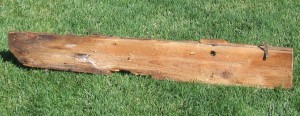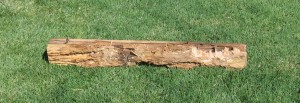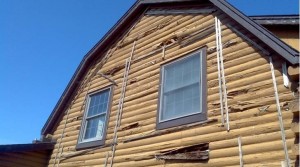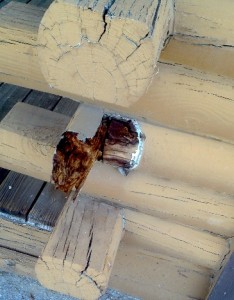GOT LOG ROT? LOG REPAIR VERSUS LOG REPLACEMENT
 How do you know if your log home has rotten logs? One method is to knock on the logs. This method is not always a fool proof way to locate rotten logs, but it works 90% of the time. The healthy logs will sound solid. If there is a hollow or soft area in the log, you will experience a noticeably different sound. Don’t forget to tap on the logs directly below the windows. This is one of the first areas to show signs of rotting. Looks can be deceiving, because even though the exterior of the log appears solid (pic- above right), the interior may be in decay (pic-below left).
How do you know if your log home has rotten logs? One method is to knock on the logs. This method is not always a fool proof way to locate rotten logs, but it works 90% of the time. The healthy logs will sound solid. If there is a hollow or soft area in the log, you will experience a noticeably different sound. Don’t forget to tap on the logs directly below the windows. This is one of the first areas to show signs of rotting. Looks can be deceiving, because even though the exterior of the log appears solid (pic- above right), the interior may be in decay (pic-below left).
 Log ends are also common areas for log rot, especially if they stick out past the overhangs of the house. Excessive checking, or cracks, may be an indicator that the log is starting to decay. Once a problem log is located, place a piece of masking tape to mark it for repair. DO NOT start tearing or digging out the surface of the log to determine how deep the rot has gone. This is the point to call in a professional.
Log ends are also common areas for log rot, especially if they stick out past the overhangs of the house. Excessive checking, or cracks, may be an indicator that the log is starting to decay. Once a problem log is located, place a piece of masking tape to mark it for repair. DO NOT start tearing or digging out the surface of the log to determine how deep the rot has gone. This is the point to call in a professional.
Once the rot has started, it goes through several stages. Fungus may begin to grow either on the outside or the inside of the log, often leaving a hollow cavity. If the decay has not progressed to the point where it structurally affects the log, the log may be treated from the inside out, restoring the structural soundness and preventing further decay. This also allows the exterior of the log to remain intact, and therefore, keep the overall consistency of the home’s aesthetics.

If the log cannot be saved, it must be removed and replaced. This involves shoring up the wall, systematically removing the rotten log and replacing it with a new log (pic-right). The nearby logs are then treated to prevent any spores from spreading to previously undamaged logs. If a log needs to be replaced, Alpine Blue is able to match almost any log profile. The next step is to stain the log in order to get as close as possible to the original patina.
Maintenance is not one of the more glamorous aspects of log home ownership. Fortunately, with planning and vigilance, you can keep your investment beautiful and secure with little cost and effort. Simply by ensuring that the proper stain and application method are used and regularly maintained on your log home is the best defense for avoiding these types of log repairs.
TIME TO CONSIDER LOG HOME MAINTENANCE…?
 Before you run to the nearest hardware store and start trying to fix everything yourself, here are a few tips that may save you a lot of time and money in the long run. Beware of the “know-it-all” handyman or painter who may give you poor advice. Many of the products that you might use on a conventional house can cause a lot of damage when used on a log home. Logs need to breathe…what moisture gets in, must get out!
Before you run to the nearest hardware store and start trying to fix everything yourself, here are a few tips that may save you a lot of time and money in the long run. Beware of the “know-it-all” handyman or painter who may give you poor advice. Many of the products that you might use on a conventional house can cause a lot of damage when used on a log home. Logs need to breathe…what moisture gets in, must get out!
• If it is not made by a company that only makes log home products, don’t buy it!
• Never use deck/siding stain on your log home. These products trap water and moisture in the log, eventually causing it to rot.
• NEVER paint your logs! Nothing makes a log rot faster (see inset pictures).
• Never use expanding foam. It acts like a sponge, drawing in water and holding it in the logs.
• Never use silicone caulking on the logs. It isn’t designed to stick to the logs and thus allows moisture to be trapped once it gets in.
• There are better ways to clean logs other than sanding. Sanding should be a last resort, as it causes major color variations, among other issues.

The easiest way to get the right information is to call a log home maintenance contractor, like Alpine Blue Log Homes, Inc., to come out and assess your home’s needs.
Our log home specialists are certified in determining the correct products and application methods for your log home. We use only log home products made by reputable log home product companies, such as Perma-Chink, Sascho and Weatherall. While other products may be cheaper or more readily available, log home stains and caulking are specifically designed to adhere to logs and stretch to maintain a tight seal by following log movement.
Do it right, do it once…call us first!
